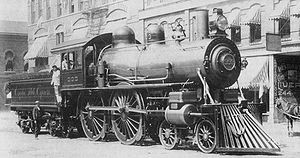- New York Central and Hudson River Railroad No. 999
-
NYC #999 
Engine 999 in Syracuse. Power type Steam Builder NYC West Albany Shops Build date 1893 Configuration 4-4-0 Gauge 4 ft 8 1⁄2 in (1,435 mm) Driver diameter 86.5 in (2,197 mm) Weight on drivers 84,000 lb (38.1 tonnes) Locomotive weight 124,000 lb (56.2 tonnes) Boiler pressure 180 lbf/in² (1,241 kPa) Cylinders Two, outside Cylinder size 15 in (381 mm) Career New York Central and Hudson River Railroad Number 999, renum 1086 in 1913 First run May 1893 Retired 1952 Current owner Chicago Museum of Science and Industry Disposition static display In the early 1890s, the competition between the New York Central and Pennsylvania Railroads was growing fiercely. Their rivalry was particularly noticeable along their Chicago to New York corridors in the years leading to the Chicago World's Fair, with both roads trying to provide the most swift service to the fair. The Pennsylvania had upgraded its Pennsylvania Limited with the most modern and efficient rolling stock of the time. The New York Central responded not only with new passenger cars for its Empire State Express, but a new, faster engine as well.[1]
The 999 was mounted on 86-inch (220 cm) diameter driving wheels, and was the first of its kind to have brakes mounted to the front truck. The bands, pipes, and trim were highly polished; the boiler, smokestack, domes, cab, and tender were given a black satin finish, and "Empire State Express" was applied to the sides of the tender in 2 ft 6 in (762 mm) high gold leaf lettering.
 New York Central and Hudson River Railroad No. 999, the "Queen of Speed," slows to 60 mph (97 km/h) as it leads the Empire State Express through Palatine, New York in 1905.
New York Central and Hudson River Railroad No. 999, the "Queen of Speed," slows to 60 mph (97 km/h) as it leads the Empire State Express through Palatine, New York in 1905.
No. 999 entered service in May 1893, making the trip from Syracuse, New York. The Express was recorded traveling at 112.5 miles per hour (181.1 km/h) by unofficial timers during an exhibition run between Batavia and Buffalo on May 10, theoretically making No. 999 the fastest-moving manmade invention of its time and the first object on wheels to exceed 100 mph. However as the recordings were never made by an official and lacked accreditation, the claim of 100 miles per hour (160 km/h) could be disputed and should not be taken as fact. Over 3,000 20 in (508 mm) gauge scale replicas (most likely made by the Cagney Brothers and known as therefore "Cagneys") were sold at $1,500 each and shipped to amusement parks as far away as South Africa and Thailand; one such unit, nicknamed the "Little Puffer" is in service today at the Fleischaker Zoo in San Francisco, California. Manufacturers of electric train sets began putting No. 999 on their locomotives.
Advances in locomotive design, particularly the advent of diesel-electric power, eventually rendered No. 999 obsolete. After touring the nation and making appearances at numerous expositions including the Chicago Railroad Fair, the unit was retired from service in May, 1952 at which time it was relegated to yard switching service in western New York shuttling express service milk cars. At this time, the railroad appeared to turn its back to steam power, and consequently, the majority of their steam engines, including all of their famed Hudsons, had been scrapped. Fortunately, when the matter of 999 came about, the road saw fit to preserve the famous engine. The New York Central donated the locomotive to the Chicago Museum of Science and Industry in 1962, though it did not arrive at the museum until 1968.
Once there, while its preservation was assured, the engine was displayed outside where exposure to elements had taken its toll over the years. In 1993, the museum underwent a major renovation. This project included a cosmetic restoration of number 999, and it was placed inside the museum's main hall. The unit as displayed lacks its original 86" drivers, which were removed sometime after the historic speed run and replaced with smaller diameter driving wheels.[2]
References
- Goldberg, Bruce (1981). Amtrak: The First Decade. Silver Spring, MD: Alan Books.
- Hollingsworth, Brian and Arthur F. Cook (1987). The Great Book of Trains. Portland House, New York, NY. ISBN 0-517-64515-7.
- "Empire State Express No. 999". Genesee County, New York. http://www.co.genesee.ny.us/dpt/historian/ese999.html. Retrieved March 1, 2006.
- ^ Fleet-wheeled wonder
- ^ John Lienhard. "Rain, Steam & Speed: Inventing Powered Motion". http://www.kuhf.org/cdprojects/steam/track12.html. Retrieved 2007-01-28.
External links
Categories:- 4-4-0 locomotives
- New York Central Railroad locomotives
- Passenger locomotives
- Steam locomotives of the United States
Wikimedia Foundation. 2010.

